| View previous topic :: View next topic |
| Author |
Message |
Jean Sendero

Joined: 20 Dec 2009
Posts: 270
Location: Hudson Heights, Quebec



|
 Posted: Jul 23, 2011 11:26 Post subject: Calcite and Fluorite from Naica, Chihuahua, Mexico Posted: Jul 23, 2011 11:26 Post subject: Calcite and Fluorite from Naica, Chihuahua, Mexico |
|
|
Since more or less April of this year, we have seen some large calcite, quite lustrous, almost yellow, yellow beige associated with fluorite coming out of Naica. The fluorite forms nice octahedron of lilac color with a poor luster with very sharp edges. I have seen some of these fluorite individual crystals reaching between 3-5 cm but are generally around 1 cm in size. The individual calcite crystals that i have seen can be as large as 10 cm. Below is a pic of a combo specimen which, I believe, illustrates better what I am trying to describe above.
My question: Does anyone has knowledge of a more precise location for these. (i.e. level?, Manto? Chimney?.....)
Cheers
Jean
| Description: |
Calcite with Fluorite
Naica Mine, Chihuahua, Mexico
11 x 8 cm
Calcite is 8 x 8 cm |
|
| Viewed: |
25803 Time(s) |
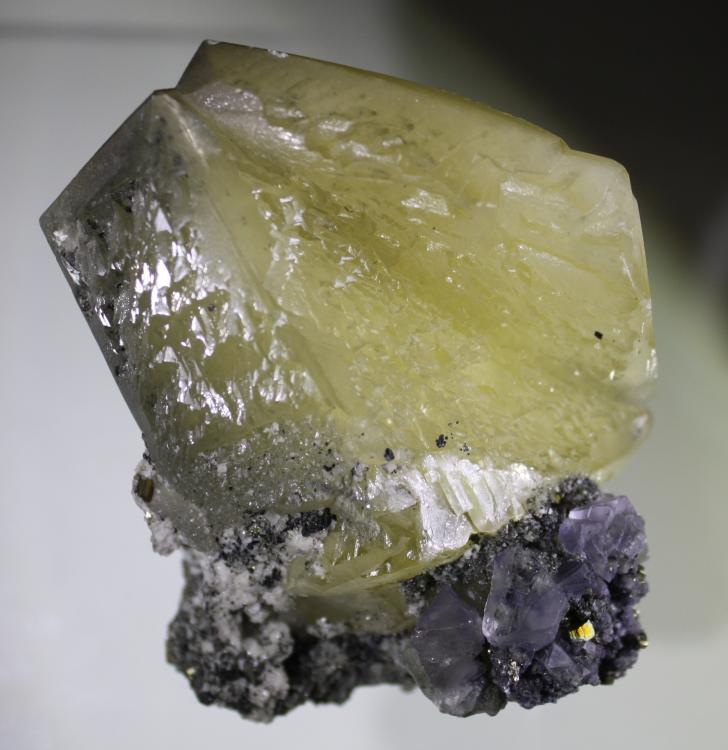
|
|
|
| Back to top |
|
 |
Peter Megaw
Site Admin

Joined: 13 Jan 2007
Posts: 973
Location: Tucson, Arizona



|
 Posted: Jul 26, 2011 11:29 Post subject: Re: Calcite and Fluorite from Naica, Chihuahua, Mexico Posted: Jul 26, 2011 11:29 Post subject: Re: Calcite and Fluorite from Naica, Chihuahua, Mexico |
|
|
Jean: These calcites and fluorites...also commonly associated with large blue free-standing anhydrite...come from an area of the mine between the 700 and 760 meter levels called "Mantos Mixtos". As far as I can tell this name comes from Naica's historical misuse of the terms manto and chimney. Naica gives these terms compositional definitions instead of geometric...so they call sulfide bodies chimneys and skarn bodies mantos as opposed to classic usage of chimneys being pipe-like high angle to vertical bodies and mantos being relatively flat-lying ribbons or sheets of mineralization. Under classic usage a chimney can be either sulfides or skarn...or both...likewise with a manto. At Naica some of the chimneys (classic usage) are sulfide near their tops, with skarn appearing in the core of the chimney farther down, ultimately reaching the point where the whole chimney is skarn...with a dike in the middle. (There's a diagram of this in our 1988 Economic Geology paper).
The "mantos mixtos" seem to be alternating flat lying bodies of skarn and sulfide, so now they've got their local terminalogy as mixed up as the composition.
At this depth....760m (measured from adit level, which is itself nearly 200m below teh surface outcrops of the orebodies) the Naica Mine is incredibly hot...52 degrees Celsius (125 F) with water of that temperature pouring out of every fracture. Naica currently mines/pumps 32 tonnes of water for each tonne of ore mined. The mining is highly mechanized, with the operators having nifty little air-conditioned cabs on their drills and scoops. They also have neat little air-conditioned cabins in the stopes...about 2/3rds the size of a shipping container. Every half hour the miners working in the open mine atmosphere must spend 10-15 minutes cooling off and rehydrating in the cabin. Expensive, but needed for the health and safety,,,and productivity of the miners
| Description: |
Anhydrite on Calcite and fluorite
Mantos Mixtos, 700-760 Level Naica Mine, Naica, Chihuahua, Mexico
30 cm
Massive plate of golden calcite crystals (on smaller fluorite) with 10 cm anhydrite crystals. (Brother to a piece posted earlier by javmex). Piece now in collection of New Mexico Tech |
|
| Viewed: |
25706 Time(s) |
![DSC00960[1].jpg](files/dsc009601_108.jpg)
|
_________________
Siempre Adelante! |
|
| Back to top |
|
 |
javmex2
Joined: 06 Sep 2010
Posts: 120
Location: Chihuahua



|
 Posted: Jul 27, 2011 13:39 Post subject: Re: Calcite and Fluorite from Naica, Chihuahua, Mexico Posted: Jul 27, 2011 13:39 Post subject: Re: Calcite and Fluorite from Naica, Chihuahua, Mexico |
|
|
Hi Peter, it is rare to see these mineral associations, even in Naica, but I was surprised of the samples can be found in these places and especially in this part which called the mantle mixed wing, where he previously also came twinned fluorite crystals spinel associated with quartz and calcite, Naica years ago as a miner working on and it is interesting to see how in these vents, where they meet the contacts of sulfides and silicates can be found as fluorite diverse associations of the three colors green, white, and purple associated with quartz and calcite, chalcopyrite, or manganocalcita with anidrita much rarer still encrusted with selenite anidrita ..
| Description: |
fluorite
Naica Chihuahua Mexico. |
|
| Viewed: |
25612 Time(s) |
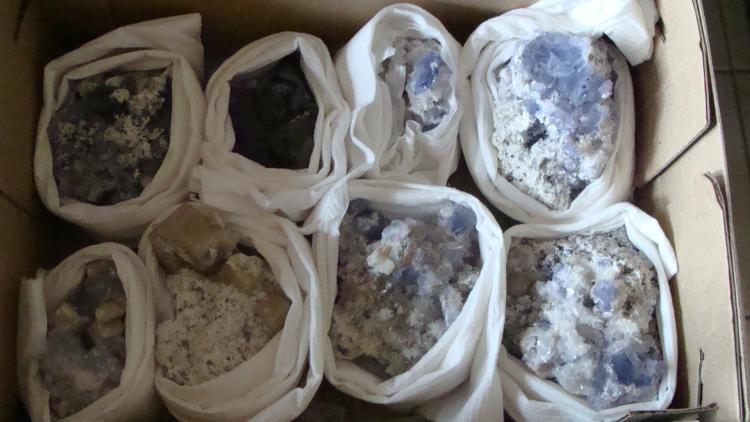
|
|
|
| Back to top |
|
 |
Jean Sendero

Joined: 20 Dec 2009
Posts: 270
Location: Hudson Heights, Quebec



|
 Posted: Jul 27, 2011 15:21 Post subject: Re: Calcite and Fluorite from Naica, Chihuahua, Mexico Posted: Jul 27, 2011 15:21 Post subject: Re: Calcite and Fluorite from Naica, Chihuahua, Mexico |
|
|
Replies came in just in time, I am back in town and can comment.
Thanks Peter and Javier. I have one more question however which result in the comment made by Javier which says "encrusted with selenite and? anhydrite? Can we have both together? Do we know at what depth, mas o menos, does the anhydrite starts to occur?
In regards to the heat in the mine, I surely recall in 1995 when I visited underground that it was incredibly hot and humid. At one point, we crossed a thin wall of water caused by a fracture crossing the drift. One side side "cool" where on the other side, two miners were working (i.e. I did not see any AC then). I could not stay on that side, for more than 2-3 minutes. There was no ventilation installed yet and there was just no air to breath. I recovered a few small pieces of gypsum from there which was level 530. It was so hot and humid that the camera (film in those days) stopped functioning properly after some time on that level.
Cheers
Jean
|
|
| Back to top |
|
 |
John S. White
Site Admin

Joined: 04 Sep 2006
Posts: 1298
Location: Stewartstown, Pennsylvania, USA



|
 Posted: Jul 27, 2011 18:09 Post subject: Re: Calcite and Fluorite from Naica, Chihuahua, Mexico Posted: Jul 27, 2011 18:09 Post subject: Re: Calcite and Fluorite from Naica, Chihuahua, Mexico |
|
|
My pedantic nature rears its ugly head again, but can we please call gypsum gypsum, and not selenite?
_________________
John S. White
aka Rondinaire |
|
| Back to top |
|
 |
Peter Megaw
Site Admin

Joined: 13 Jan 2007
Posts: 973
Location: Tucson, Arizona



|
 Posted: Jul 27, 2011 21:32 Post subject: Re: Calcite and Fluorite from Naica, Chihuahua, Mexico Posted: Jul 27, 2011 21:32 Post subject: Re: Calcite and Fluorite from Naica, Chihuahua, Mexico |
|
|
John...I'll see your pedantry and raise you...If there was ever gypsum that qualified to be called selenite it is the large water clear crystals from Naica.
I will attempt to walk this pedantic-sematic tightrope in what follows....
Jean...you raise an interesting point regarding the coexistence/co-occurrence gyspum and anhydrite. This is actually fairly common at Naica...over the years I have seen spectacular specimens of 8 cm long blue anhydrite enclosed in 20 cm gypsum var. selenite crystals (if it wasn't transparent selenite we would be hard pressed to see the anhydrite). Geochemically this "should not happen"...the two should not deposit simultaneously (failing really restricted chemical conditions) and closer examination shows not only a significant paragenetic separation but that a thin film of calcite coats the anhydrite and allows it to persist under the conditions of gypsum deposition, so they are not truly co-deposited. I have several excellent samples of hollow calcite epimorphs/partial psuedomorphs (?) after anhydrite showing that it did not survive unless the coating was complete.
The overall mine paragenesis shows that the anhydrite formed fairly early during high temperature sulfide formation (I've seen dustings of pyrite, sphalerite and galena sometimes with fluorite on anhydrite. I have never seen any skarn silicates younger than the anhydrite though) ...it later got covered with calcite (typically manganoan...red-orange fluorecent under SWUV... probably forming from waning ore fluids) and at some much later time gypsum was deposited. Gypsum deposition probably began when the temperature dropped below about 100 degrees C and massive amounts of oxegenated meteoric waters began to circulate through the ore zone. Gypsum deposition continues today with all kinds of mine junk getting coated with beautiful elongate selenite as well as iron-oxide included gypsum crystals. The latter show an interesting effect themselves...in some places the conditions are reducing so the iron deposits as a green inclusion/coloring...in other areas the conditions are oxidizing so the iron deposits as a golden inclusion/coloring. (My favorite fakes from Naica are where folks have glued green crystals onto a golden specimen and vice versa...fun things to hand mineralogy students and ask "what's wrong with this specimen"?)I
I think that the extremely long period of gypsum deposition...from now, back to when the system cooled to under 100 degrees C that it would be necessary to try to compare truly old gypsum to the anhydrite. I would not be surprised if there was a significant sulfur or oxygen isotope difference between the old and new gypsum...thesis anyone?
As to vertical extent of anhydrite...access has long been blocked to the oxidized uppermost levels (above the "0" m adit level) of the major Torino-Tehuacan Chimney, the only significant orebody to extend high enough to be exposed by erosion, so I don't know if anhydrite was present there (gypsum certainly was). However I saw abundant anhydrite in the upper sulfide levels of this chimney in the 1980s...in active stopes as high as the 220m level. Specimens came out well before then, so I suspect anhdrite was present in the highest levels of sulfide mining. Gypsum caves of course persist to at least the 500m level and gypsum crystals deposit everywhere to the bottom of the mine.
All in all I believe that the paragenetic differences are so extreme (rising early fluids versus late cool meteoric-water dominated fluids) that no systematic relationship exists...or should be expected.
This raises some interesting ancillary questions.
1. How fast does the gypsum really grow? Workers on the Cave of the Giants say millions of years, classic crystal growth science would suggest months to years.
2.. Why is the hydrothermally deposited anhydrite blue, whereas the thermally metamorphosed sedimentary anhydrite cut in deep cores purple?
3. Why is Naica full of anhydrite, while sister-deposit Santa Eulalia 100 km up the road and hosted in the same anhydrite-gypsum rich stratigraphic section have vanishngly small quantities of anhydrite?
3.
| Description: |
Gypsum
Naica Mine, Chihuahua, Mexico
7 cm
Small group of neogenic gypsum crystals formed in a mine sump. Shows two stages of gypsum growth...an early transparent "selenite" stage of long crystals and a later coating of dusty fine-grained gypsum |
|
| Viewed: |
25528 Time(s) |
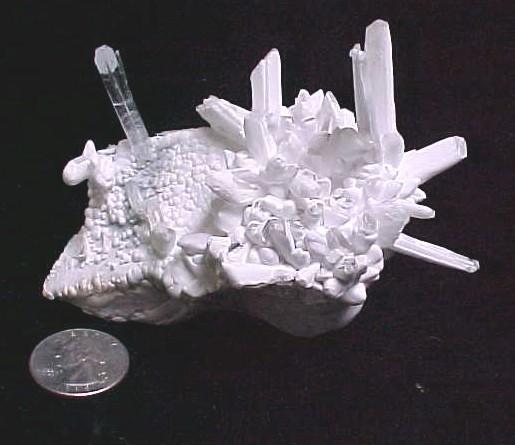
|
_________________
Siempre Adelante! |
|
| Back to top |
|
 |
John S. White
Site Admin

Joined: 04 Sep 2006
Posts: 1298
Location: Stewartstown, Pennsylvania, USA



|
 Posted: Jul 28, 2011 04:20 Post subject: Re: Calcite and Fluorite from Naica, Chihuahua, Mexico Posted: Jul 28, 2011 04:20 Post subject: Re: Calcite and Fluorite from Naica, Chihuahua, Mexico |
|
|
Peter:
I have always believed that "simultaneous" meant happening at the same time. If there is anhydrite encased in transparent gypsum, then the two did not crystallize simultaneously, and I imagine that the thin calicte film over the earlier anhydrite might not even be necessary.
I am curious about the blue color of the anhydrite. Is any of this type of anhydrite from this occurrence not blue in color?
_________________
John S. White
aka Rondinaire |
|
| Back to top |
|
 |
Jean Sendero

Joined: 20 Dec 2009
Posts: 270
Location: Hudson Heights, Quebec



|
 Posted: Jul 28, 2011 08:06 Post subject: Re: Calcite and Fluorite from Naica, Chihuahua, Mexico Posted: Jul 28, 2011 08:06 Post subject: Re: Calcite and Fluorite from Naica, Chihuahua, Mexico |
|
|
Thanks Peter,
Early anhydrite preserved by a thin calcite coating to allow later deposition of gypsum seems to make sense. It seems a little strange however that sulphides can be coating anhydrite where the precipitation temperatures should be different under the same pressure conditions. Anhydrite should precipitate following a drop of temperature hence towards the end of the system, no?
I would be very curious to see indeed some Sulfur isotopes done on both the gypsum and anhydrite. It would surely contribute in answering question 3. Or could question 3 be simply answered with the possibility that the anhydrite was present but was later destroyed, dissolved with the gradual evolution of the fluids?
Cheers
Jean
|
|
| Back to top |
|
 |
javmex2
Joined: 06 Sep 2010
Posts: 120
Location: Chihuahua



|
 Posted: Jul 28, 2011 11:14 Post subject: Re: Calcite and Fluorite from Naica, Chihuahua, Mexico Posted: Jul 28, 2011 11:14 Post subject: Re: Calcite and Fluorite from Naica, Chihuahua, Mexico |
|
|
A picture of when working in the mine Naica, the image quality is not good devido a camera that is not appropriate for this place where the temperature is way too high and contains moisture.
| Description: |
Javmex ,
Naica Chihuahua Mexico. |
|
| Viewed: |
25423 Time(s) |
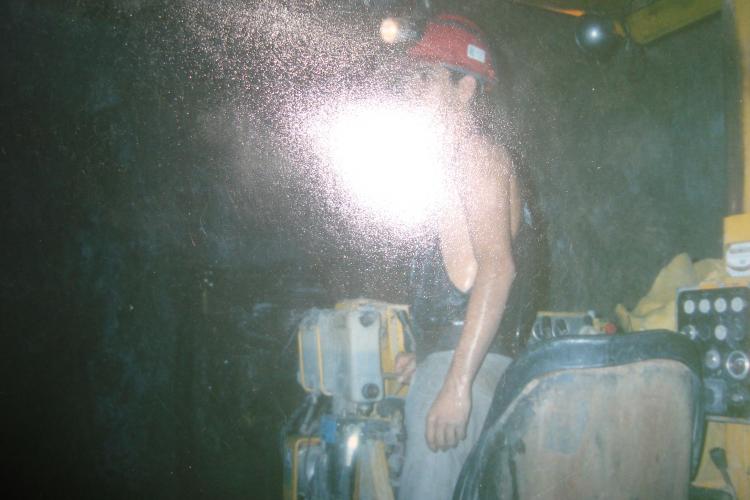
|
|
|
| Back to top |
|
 |
Peter Megaw
Site Admin

Joined: 13 Jan 2007
Posts: 973
Location: Tucson, Arizona



|
 Posted: Jul 28, 2011 11:45 Post subject: Re: Calcite and Fluorite from Naica, Chihuahua, Mexico Posted: Jul 28, 2011 11:45 Post subject: Re: Calcite and Fluorite from Naica, Chihuahua, Mexico |
|
|
John...thanks for the correction...I should have said "consanguinously" in the sense of forming from the same packet of hydrothermal fluids, which the literature indicates should be difficult to do.
I have seen very small amounts of coarse hyrdothermal anhydrite from Naica that is a very pale gray to off white, but 99.9% of what I've seen, in the mine and as specimens is somewhere in the blue to blue-gray range. The only violet anhydrite I've seen from there is in drill core from the metamorphic halo...essentially recrystallized anhydrite "marble". I have seen similar violet anhydrite from similar environments in other systems...and of course both violet and colorless anhydrite is common in Porphyry Copper Deposits...though seldom well preserved.
Jean...The literature on anhydrite-gypsum stability fields shows that the mutual field boundary is near vertical on a P/T diagram...essentially fixed at around 45-50 degrees C with slight effect of increased pressure. However the relationships are significantly affected by salinity, XCO2 and XO2...and the whole thing is complicated by the sluggishness of anhydrite dissolution at low temperatures and gypsums high solubility at even slightly elevated temperatures.
Since at least some of the anhydrite precipated at the time of sulfide deposition (I neglected to note earlier that we also see Baryte with pyrite inclusions overgrowing anhydrite) we can assume temperatures above 250 degrees C (this from the abundant literature on the formation of the Naica deposit) ...well beyond the 50 degree gypsum stability limit. It may be late with respect to much of the sulfide deposition, but still must be forming well before gypsum stable conditions appear.
Given the range of fluctuating conditions that must have occurred between precipitation of the anhydrite and the system reaching conditions of gypsum stability it seems likely that the anhydrite would have been redissolved and/or at least severely corroded making the deposition of transparent sharp gypsum crystals on sharp unarmored anhydrite unlikely, which fits with the calcite armoring and epimorphs that we see.
This may be what happened at Santa Eulalia as well, but without preservation of relict anhydrite indicators. I have one specimen of calcite epimorphs after probable anhydrite and know of a single specimen of hydrothermal anhydrite from SE. However given the size of Santa Eulalia and the paucity of anhydrite indicators in most other Mexican CRD-skarn systems this seems unlikely. Naica may be special in some way...it is still pumping huge amounts of geothermally driven sulfate-laden waters and the ore-related fluid inclusions at Naica are crowded with daughter minerals (up to 17 have been noted in a single inclusion) while those at Santa Eulalia contain 1-3 daughters max. Perhaps the difference stems from fluid concentrations and overall S supply or volume of fluids pumped through the system?
There is a significant body of isotopic work on the anhydrite and gypsum at Naica and Santa Eulalia...and elsewhere. Some of it can be found in the scientific literature surrounding the Cave of the Giants...see the paper in Geology 3-4 years back. The isotope data are generally interpreted as indicating a sedimentary S source (the thick evaporites of the Cuchillo Formation) but they can also be modeled as having a significant magmatic source component. What they do not appear to be is derived from oxidation of sulfides...so both the anhydrite and gypsum should be considered hypogene.
The point I was trying to make is that gypsum has precipitated at Naica over a very long time...at least 30 Million years...probably starting when the hydrothermal system cooled to 50 degrees C and continuing to the present day geothermal conditions. Given this span, these two drivers cannot be related, and there were almost certainly breaks between times of gypsum depostion (we see evidence of this in the resorbed gypsum crystals and phantoms of these surrounded by sharp later stage growth)...so it seems likely that the sulfur isotopes (oxygen too) varied over time. If true, it might be possible to distinguish or even "date" the different gypsum depositing events...at least in a relative sense.
_________________
Siempre Adelante! |
|
| Back to top |
|
 |
John S. White
Site Admin

Joined: 04 Sep 2006
Posts: 1298
Location: Stewartstown, Pennsylvania, USA



|
 Posted: Jul 28, 2011 13:19 Post subject: Re: Calcite and Fluorite from Naica, Chihuahua, Mexico Posted: Jul 28, 2011 13:19 Post subject: Re: Calcite and Fluorite from Naica, Chihuahua, Mexico |
|
|
To return to my pedantry for just a moment, and this probably should be a separate blog, it is very interesting to compare two terms with similar connotations - selenite and rock crystal. Rock crystal, as most know, refers to colorless, water-clear quartz crystals. If quartz crystals are smoky-colored, they are called smoky quartz. Yellow ones are citrine. Curiously, the term is virtually almost never abused or corrupted, as is selenite. The worst example of selenite abuse is "sand selenite," which is often encountered. How can one possibly justify calling yellow, sand-included gypsum selenite? Ah well, a losing fight, I know, but like Don Quixote I keep tilting at my own personal windmills.
_________________
John S. White
aka Rondinaire |
|
| Back to top |
|
 |
javmex2
Joined: 06 Sep 2010
Posts: 120
Location: Chihuahua



|
 Posted: Jul 28, 2011 14:34 Post subject: Re: Calcite and Fluorite from Naica, Chihuahua, Mexico Posted: Jul 28, 2011 14:34 Post subject: Re: Calcite and Fluorite from Naica, Chihuahua, Mexico |
|
|
This is a sample of what we discussed above, anidritas Embedded in the selenite. something inexplicable to my.
| Description: |
anidrite, gipsum
Naica Chihuahua Mexico.
|
|
| Viewed: |
25409 Time(s) |
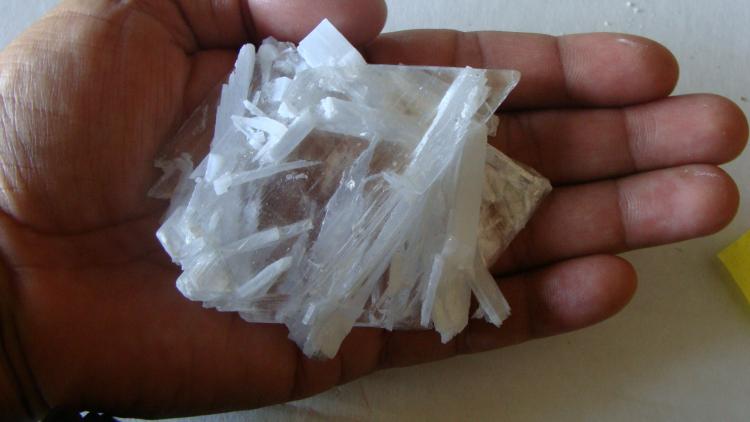
|
|
|
| Back to top |
|
 |
Jean Sendero

Joined: 20 Dec 2009
Posts: 270
Location: Hudson Heights, Quebec



|
 Posted: Jul 28, 2011 14:47 Post subject: Re: Calcite and Fluorite from Naica, Chihuahua, Mexico Posted: Jul 28, 2011 14:47 Post subject: Re: Calcite and Fluorite from Naica, Chihuahua, Mexico |
|
|
Thank you all for the interesting comments and pictures.
A simple question for a more accurate provenance ends up in as a very interesting discussion about anhydrite and gypsum.
And this is not all, a crystal clear argument for selenite vs gypsum.
Cheers
Jean
|
|
| Back to top |
|
 |
Peter Megaw
Site Admin

Joined: 13 Jan 2007
Posts: 973
Location: Tucson, Arizona



|
 Posted: Jul 28, 2011 15:38 Post subject: Re: Calcite and Fluorite from Naica, Chihuahua, Mexico Posted: Jul 28, 2011 15:38 Post subject: Re: Calcite and Fluorite from Naica, Chihuahua, Mexico |
|
|
John ...I think alliteration rules in the sand selenite vs sand gypsum battle
Jean...regarding the clarity question...the Swedes have an appropriate expression...klart som korvsbad that describes this perfectly...close relative to the English saying.clear as mud...but with somewhat less definitive opacity
Javier...great example
...is the anhydrite in direct contact with the gypsum or is there a layer of calcite. This might be an example of very recent gypsum. Tienes una extra de estos
_________________
Siempre Adelante! |
|
| Back to top |
|
 |
John S. White
Site Admin

Joined: 04 Sep 2006
Posts: 1298
Location: Stewartstown, Pennsylvania, USA



|
 Posted: Jul 28, 2011 17:54 Post subject: Re: Calcite and Fluorite from Naica, Chihuahua, Mexico Posted: Jul 28, 2011 17:54 Post subject: Re: Calcite and Fluorite from Naica, Chihuahua, Mexico |
|
|
Javier:
Many thanks for that image. I have never seen this association so it is especially nice to finally have a picture of an example.
_________________
John S. White
aka Rondinaire |
|
| Back to top |
|
 |
|




